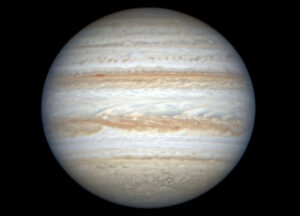Special to CosmicTribune.com, October 30, 2023, 2023
Excerpts from weekly Sky&Telescope report.
SATURDAY, OCTOBER 28
■ Full Moon (exact at 4:24 p.m. EDT). The Moon rises at sunset.
■ A very slight partial lunar eclipse occurs while the full Moon is visible from Europe, Africa, and Asia.

TUESDAY, OCTOBER 31
■ The waning Halloween Moon, three days past full, rises in the northeast soon after dark. Watch for it to come up lower right of Capella, and a similar distance lower left of the Pleiades (for North America).
WEDNESDAY, NOVEMBER 1
■ NEW: The naked-eye star Kappa Geminorum, magnitude 3.6, will be briefly occulted late tonight by a tiny asteroid (magnitude 19!) for one second or less, writes David Dunham of the International Occultation Timing Association. The occultation should occur along a path running from New Mexico through northern Virginia from 6:38 to 6:40 November 2 UT.
■ Vega is the brightest star high in the west after dark. The main stars of Vega’s own constellation, Lyra — also pretty faint — extend from Vega 7° to the side opposite the head of Draco. Farther on in that same direction, you’ll see that Lyra’s length points to Altair. This line is the bottom segment of the Summer Triangle.
■ Algol in Perseus should be at its minimum brightness, magnitude 3.4 instead of its usual 2.1, for about two hours centered on 10:12 p.m. Eastern Daylight Time, 7:23 p.m. Pacific. Algol takes several additional hours to fade and to rebrighten.
THURSDAY, NOVEMBER 2
■ The waning gibbous Moon rises around 9 or 10 p.m. Once it’s well up, you’ll see it forming a nice, not quite equilateral triangle with Castor and Pollux to its left and lower left. The triangle shrinks as the night advances and the Moon creeps toward Pollux. By dawn on the 3rd, the triangle is as shown below.

The Moon crossing Gemini in the southwest in early dawn. Yes, you can get yourself out of bed that early; we’re still not quite on standard time yet, so the Sun rises its very latest.
FRIDAY, NOVEMBER 3
■ Spot bright Altair high in the southwest soon after dark. Brighter Vega is far to its right.
Two distinctive little constellations lurk above Altair: Delphinus the Dolphin, hardly more than a fist at arm’s length to its upper left, and smaller, fainter Sagitta the Arrow, slightly less far to Altair’s upper right. Is your sky too bright for them? Use binoculars!
SATURDAY, NOVEMBER 4
■ Last-quarter Moon tonight (exactly so at 4:37 a.m. Sunday morning EDT). The half-lit Moon rises around 11 or midnight, in Cancer. Watch for it to come up over the horizon about two fists at arm’s length below or lower left of Castor and Pollux.
■ Daylight-saving time ends at 2 a.m. tonight for most of North America. Clocks fall back an hour.
SUNDAY, NOVEMBER 5
■ After dark this week, Capella shines in the northeast. The Pleiades are up in the east-northeast three fists to Capella’s right. As evening grows later, you’ll find orange Aldebaran climbing below the Pleiades. Then by about 10 p.m. (depending on your location), Orion clears the eastern horizon below Aldebaran.
Venus, brilliant at magnitude –4.4 under the hind feet of Leo, shines high in the east before and during dawn. It rises nearly 2½ hours before dawn’s first light — a weird late-night apparition coming up over the eastern horizon.
Jupiter (magnitude –2.9, in Aries) is at opposition Nov. 2nd. It rises around sunset, dominates the east during evening, stands highest in the south around 1 a.m. daylight-saving time, and sets around sunrise. In a telescope Jupiter now appears as big as it gets: 49 or 50 arcseconds wide all week. Don’t miss this chance!

You must be logged in to post a comment Login